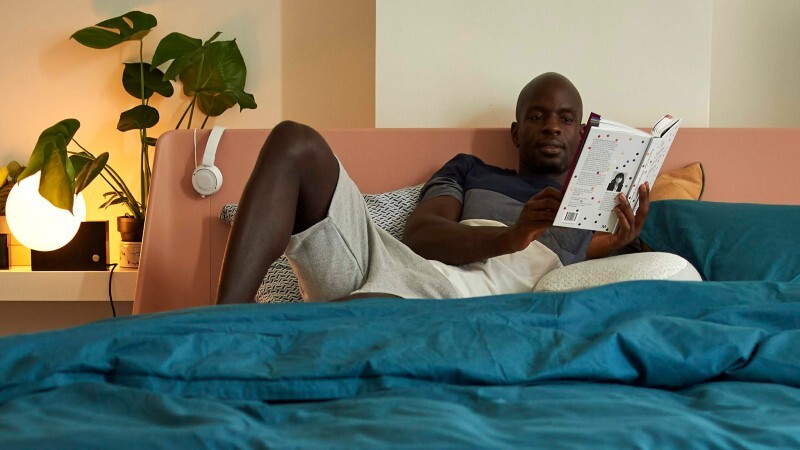We all know we should get the seven-plus hours of sleep recommended by the American Academy of Sleep Medicine. However, as anyone who’s ever spent a night staring at the ceiling knows, sometimes that’s easier said than done.
Roughly 30% of us suffer from sleep disruption. And each year one in four people develop acute or short-term insomnia—a kind of sleeplessness that occurs at least three times a week and for less than three months—according to a 2020 study in Sleep.
Many of us are tired of being tired. Globally in 2019 we spent $78.7 billion on sleep aids, which include everything from sleep trackers we wear on our wrists or slip under our mattresses to smart lights that can simulate sunset to help us wind down.
When we’re seeking sleep support, it’s not surprising that we look to science and technology for solutions. And now, a company called Somnox has created a new pillow-like robot to help guide us to dreamland. The Sleep Robot—which is actually less of a robot and more of a high-tech, bean-shaped plush pillow—promises to help us fall asleep faster, stay asleep longer, and wake up more rested.
Skeptical? We were too. Here’s how it works and what one sleep doctor thinks.
How the Sleep Robot Works
Before bedtime, you use an app to program the pillow-like pal, which generates a restful breathing rhythm that the company claims your body will unconsciously adapt to. You can also choose to program the Sleep Root to mirror your own breathing and then it will gradually slow down to a slower pace over time.
At bedtime, you bring the robot into bed with you to hug, spoon, or hold in whatever position feels most natural.
You then press the power button at the bottom of the pillow before sliding between the sheets. Underneath its soft and fuzzy plush exterior, the Sleep Robot houses a set of internal mechanical lungs that you’ll feel rising and falling alongside your body or against your chest.
You can also set your robot pillow to play soothing nature sounds or white noise specially designed to sway you into slumber. The company claims you’ll fall asleep 21 minutes faster than you would without the Sleep Robot in your arms.

While the Somnox Sleep Robot we’re describing hasn’t had its effectiveness tested and validated by clinical, peer-reviewed studies yet, the science behind it is legit, says Dr. Katherine Green, medical director of the Sleep Medicine Clinic at UCHealth University of Colorado Hospital in Aurora.
If the sleep robot works as intended, Green says that it is shifting our autonomic nervous system—the control system behind our bodies’ unconscious physiological responses, like blinking and breathing—from a state of “fight or flight” to "rest and digest” by slowing our breathing and lowering our heart rate. This is similar to what happens in the body when we “consciously” practice deep breathing and why sleep experts recommend box breathing before bed.
“During the first stage of sleep, your heart rate and breathing naturally slow and your blood pressure drops,” explains Green. “Doing that intentionally can kickstart the shift between wakefulness and sleep. A device like this is capitalizing on the idea of driving those transitions to happen in the human body.”
As for the sleep robot’s sound option, sleep experts often recommend white noise to people experiencing sleep issues. "White noise is successful in encouraging sleep onset because it helps block environmental distractions that would prevent your mind from calming down,” says Green.
How to Experience the Robot’s Sleep-Inducing Benefits for Free
So, Somnox’s Sleep Robot offers features rooted in science that may coax our bodies to sleep. At $599, however, it's quite a hefty investment for most of us.
If you can’t afford to shell out six hundred bucks for a robotic pillow pal, the good news is that there are ways you can mimic its benefits to get similar sleep results for free.
“The Sleep Robot gives you a framework in which to relax and it helps you to tell yourself: ‘this is the time that I am going to sleep, and I’m going to focus on this and not the million other things that are running through my head,’” says Green.
You can do that for yourself by creating a bedtime routine that incorporates mindfulness practices (such as guided meditation programs), deep breathing techniques (such as the box breathing method), and body scanning—a practice where we spend time individually focusing on each part of the body to encourage complete relaxation. According to a 2015 study published in JAMA Internal Medicine, when people with sleep disturbances were taught mindfulness practices, they experienced less insomnia, fatigue, and depression.
You can also experience the benefits of white noise at bedtime without spending a dime. “I don’t see anything unique or proprietary about the white noise these robots are generating,” says Green.
There are plenty of free smartphone apps that will create white noise, and there are also devices that will play all kinds of soothing sounds for under $50. And, of course, we can also listen to relaxing sleep songs for free using services like YouTube and Spotify.
Intentionality—which can be as simple as a consistent pre-sleep ritual or the use of a particular device—can be a powerful sleep aid in its own right. “If something makes you feel like you can fall asleep easier, you probably will fall asleep easier,” says Green.
As cuddly and comforting as this little sleep robot may be, we can mimic its benefits by practicing sleep hygiene and creating and committing to our own nightly bedtime rituals.
☾
If you found this article helpful, consider sharing it on Twitter, Facebook, Pinterest, or Instagram or emailing it to any friends and family members who might benefit from a better night’s sleep. Sharing is caring!






